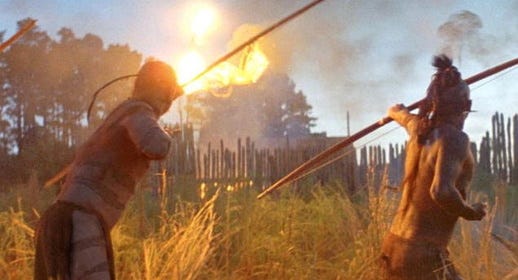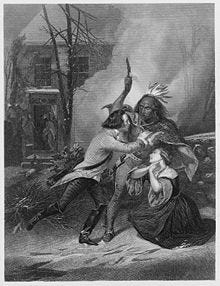Message to free subscribers of the Martyr Made Substack: We are currently on part 10 of a series about the history of slavery and the causes of the US Civil War. In true Martyr Made fashion, we’re on part 10, I’ve already written what amounts to a short book, and we are only just about to jump into the topic of slavery in the American colonies. I didn’t want to write a polemic about who was to blame for slavery or the Civil War, I wanted to dive deep and explore how these tragedies came to pass. It may seem daunting to jump into a series ten parts in, but here’s the good news: Paid subscribers have access to a special podcast feed where all of my essays are available in audio format, so you can listen to them while you drive or work. My goal with this series is for all of us to feel like we really understand slavery and the Civil War at much more than a surface level. Message to my paid subscribers: I didn’t intend on this series growing into such a beast. By the time it’s done, I wouldn’t be surprised if we’ve reached 300 pages or more. When it’s all over, I’ll put it together in eBook format for whoever wants it. That said, because I still have some ways to go on this topic, I am going to start mixing in some interviews and essays on other topics, just to break up the abjectness of historical slavery and the poverty of life in early colonial Virginia. I have been trying to get these slavery essays out at a rate of one a week, but I’ll probably stretch that out to one every ten days or so, with other content mixed in. If you guys have thoughts on this, please share in the comments. I work for you guys and no one else, so at the end of the day you’re running the show. To all of you who have been following along the whole time, as always, you are the best, and I’m grateful for your support. Oh, and I’ll have the audio versions for this and the previous installment out later today. When reading any history book, we do well to keep in mind that the succession of generations means that different people are dealing with the same problems from one chapter to the next. Regarding the Israel-Palestine conflict, I often point out to people that the cycle of violence being carried on today was started by people long dead. It may seem like a trite point, but it’s important to understand that events look very different to us, reading about them in a book, than to direct participants who were born and bred into their circumstances, and for whom the stakes were infinitely higher. Even the choices that might have been available to the earlier generation that spawned the conflict are often not available to later ones conscripted and indoctrinated into one side or the other from early childhood. The decisions they make might not make sense from a detached, “objective” point of view, but from within the storm they might not have seemed like decisions at all, but straightforward imperatives. Colonial Virginia was founded at Jamestown in 1607. The corporate structure of the colonial project, the economics of the tobacco monocrop, the disproportion of men to women in the population, the unforgiving struggle against nature for simple survival, and the savage cycle of violence and retribution with the Native Americans… all these factors and more shaped the society that emerged out of those early years. It was a society whose familiarity with death matched that of a society suffering under plague, and for whom brutal, hand-to-hand violence was not a theoretical consideration, but something that could invade your home at night to kill you and your family. It was also a class-conscious society where human life was cheap, and the poor were there to be used up and discarded to make a few men rich. By the late 1600s, whether Virginia society would survive was no longer in doubt, but the question of what kind of society it would be was finally coming to a boil. The tipping point came with a new round of Indian violence in 1675-6. The tribes surrounding the Virginia territory had been subjugated and reduced to the status of tributary “allies,” but just beyond those tribes, and sometimes among them, were others who were not party to the treaty, and continued to mount raids on Virginia farms strung out along the rivers. Virginians had almost no idea what was going on even a few miles beyond their immediate frontier, and the Indians’ ability to strike anywhere and then melt away into the woods made it seem like they were far more numerous than they were. To most Virginians, one Indian looked and behaved like another, and the great fear was that the “allied” tribes would side with Virginia’s enemies - be they Spanish, Dutch, or other natives - at the first viable opportunity. In April 1676, a group of Doeg¹ tribal warriors seized a few hogs from a colonist named Thomas Mathew, as payment for a deal on which Mathew was said to have welched. In response, Mathew mounted a posse to go after the “thieves,” and ended up beating or killing some of them. Naturally, the Doegs retaliated, and one of Mathew’s hapless servants was killed by raiders. Two prominent men from the core counties, both of whom had been previously disciplined for their behavior toward the Indians, took it upon themselves to send the Indians a stern message. One mounted a larger raid across the river, indiscriminately killing 14 Susquehannah natives before realizing that he’d targeted the wrong tribe. The other lured out a group of Doegs, under flag of parley, where a group of Virginians murdered ten of them, including a chief. The Susquehannahs, who had not previously been in conflict with the Virginians, had recently been driven from their traditional territory by hostile Seneca Indians, and had taken refuge with the friendly Piscattaway tribe in a fort set up for them across the Potomac by the Maryland colony. Incensed at the murder of their kinsmen, the Susquehannahs launched raids on Virginia from their Maryland safe haven. A militia of nearly 1,000 Virginians was mustered to march on the fort. During the siege, five Susquehannah chiefs rode out to negotiate terms of peace, but they were all seized and murdered. After ten days, the Indians made a desperate attempt to break out, punching a hole in the leaky Virginia lines and escaping into the forests of the Upper Rappahanock, living off the land and attacking Virginians whenever the opportunity presented itself. The Indians matched or exceeded the Virginians’ own savagery, falling upon isolated farmhouses, killing everyone they could and, if they managed to get all the men under control and didn’t have reason to worry about approaching reinforcements, often taking time for torture and mutilation. Sometimes only the men were killed, and the women and children taken as captives. Historian Paul Johnson, in his A History of the American People, writes that:
Rumors swirled among Virginians in the outlying counties, the ones nearest to the surrounding tribes, that the Indians were working to unite for a concerted attack against the settlers. It did not help matters that the Indian attacks of 1675-6 came at the same time that an alliance of tribes launched a savage war of attempted extermination against the settlements of Massachusetts, in which over 2,000 Puritan men, women, and children were killed. In fact, Indian tribes were becoming restive up and down the coast, feeding the fear that a grand indigenous alliance would emerge to push the whites back into the sea. The counties on the front lines were also the poorest counties of Virginia, full of men who already felt overtaxed and underrepresented by the colony government. Just a few years before this time, Governor William Berkeley had barely managed to keep the lid on a potential mutiny among freemen in Surrey and New Kent, and now, as the Susquehannah raiders made their way south toward them, the men of those counties demanded an aggressive defense. Berkeley, too, was concerned about the possibility of a general alliance of Indians, but for that very reason was reluctant to do anything that might antagonize the tribes nearby. In case their worst fears were realized, any tribes that could be retained as allies would be invaluable as spies, scouts, trackers, and warriors against hostile Indians. Thus, in early 1676, when the Susquehannah raiding parties were making their way south along the river heads, Berkeley commissioned an officer to lead a contingent of volunteers against them, but, at the last moment, called off the operation and opted to take a defensive posture. When the raiders were confirmed to have made it as far as the falls of James River, a special assembly was called to consider options. The upriver men offered themselves as a militia to take the offensive and put an end to the threat. They asked that the governor give his blessing and appoint an officer to lead them, but the assembly was dominated by Tidewater elites who distrusted the rough, upriver farmers almost as much as they distrusted the Indians. They feared what would happen if those men got organized and gained a new appreciation for the power of their numbers. Instead, the men in the counties under threat were told to stand down, and the assembly ordered the construction of a series of forts, to be manned by 500 soldiers drawn from the Tidewater counties. This was close to the final straw for the men of the Southside. The forts would be built on unoccupied upriver lands owned by the colony’s elite, who would be paid handsomely out of the public treasury. Each of the 500 soldiers was to be paid 1,500 pounds of tobacco, more than a farmer on marginal upriver land would earn in a year. This was particularly galling, since the frontiersmen had offered to provision themselves, and to serve in the militia without pay. Worse, the frontiersmen immediately saw that the forts would be useless to defend against small raiding parties, which could emerge from the woods at a place and time of their choosing, attack a farm, and be long gone before word ever reached the fort. As if to guarantee their uselessness, the assembly ordered that no action against hostile Indians could take place until the governor was notified and gave his official approval. Nevertheless, another huge tax increase would be necessary to pay for all these things. Finally, by enlisting only men from the wealthier downriver counties, the assembly sent the unmistakable message that the forts and soldiers were meant to keep watch over restive Virginians as much as they were to defend against Indian raids...  Continue reading this post for free, courtesy of Darryl Cooper.A subscription gets you:
|
Search thousands of free JavaScript snippets that you can quickly copy and paste into your web pages. Get free JavaScript tutorials, references, code, menus, calendars, popup windows, games, and much more.
The Peculiar Institution, pt. 10
Subscribe to:
Post Comments (Atom)
When Bad People Make Good Art
I offer six guidelines on cancel culture ͏ ͏ ͏ ͏ ͏ ͏ ͏ ͏ ͏ ͏ ͏ ͏ ͏ ͏ ͏...
-
code.gs // 1. Enter sheet name where data is to be written below var SHEET_NAME = "Sheet1" ; // 2. Run > setup // // 3....



No comments:
Post a Comment